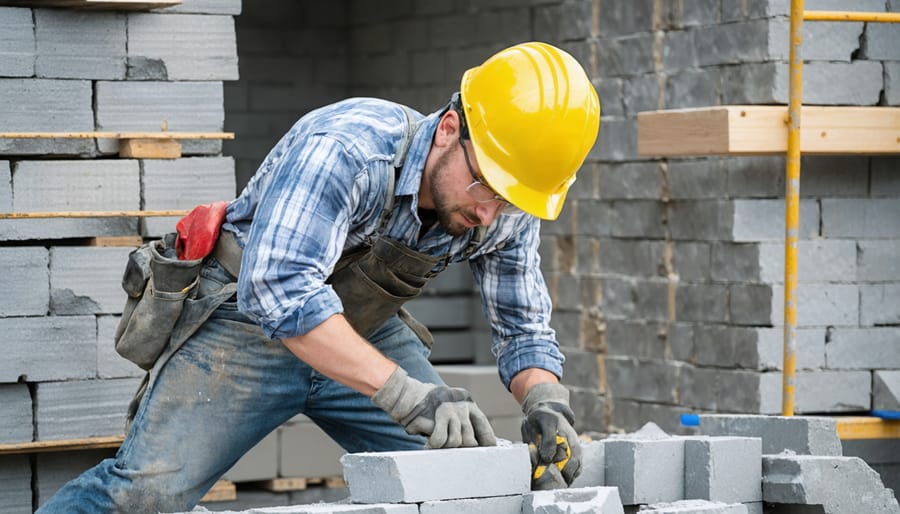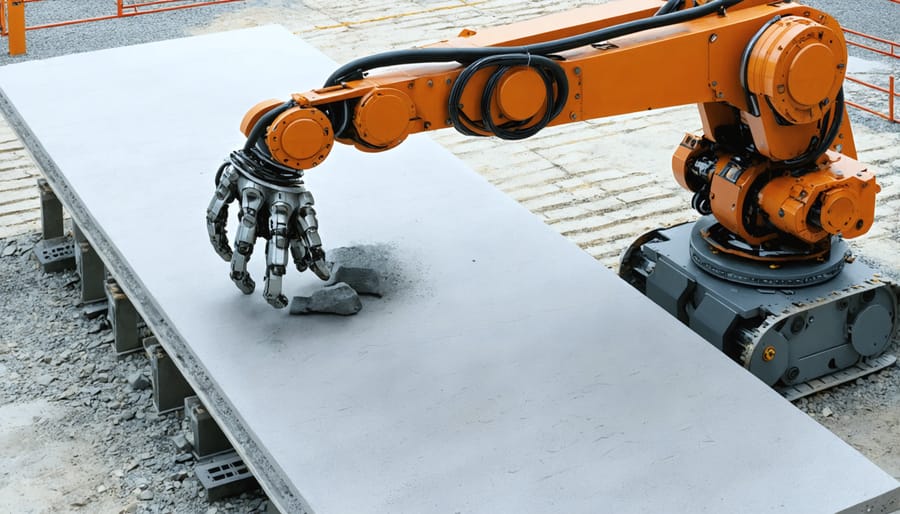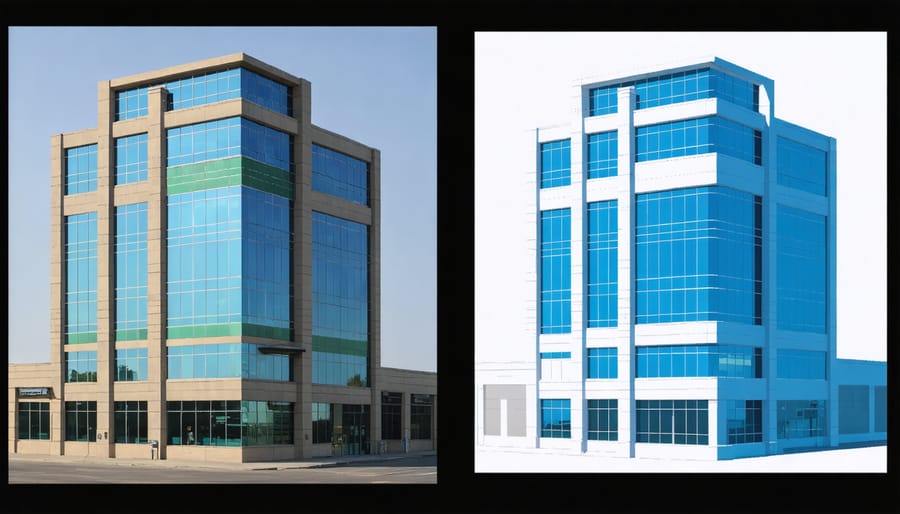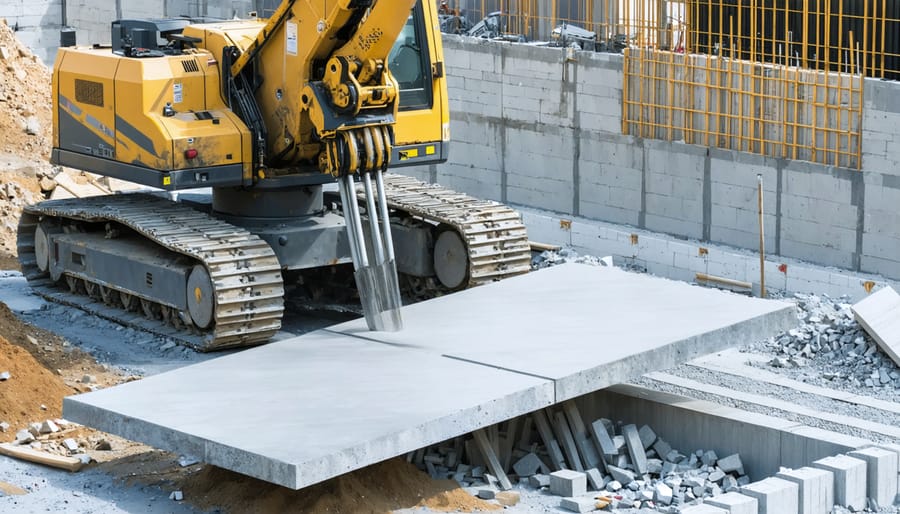Construction automation and robotics are revolutionizing the building industry, transforming how we approach everything from basic assembly to complex natural stone installation costs and project management. Advanced robotic systems now handle tasks that once required extensive manual labor, reducing workplace injuries by up to 50% while increasing productivity by as much as 300%.
From autonomous brick-laying machines capable of placing 3,000 bricks per day to AI-powered project planning software that optimizes resource allocation in real-time, these technologies are redefining construction efficiency. Sophisticated stone-cutting robots achieve precision within 0.5mm tolerance, dramatically reducing material waste and installation time. Meanwhile, drone-based surveying and monitoring systems provide unprecedented oversight of construction sites, enabling real-time quality control and progress tracking.
The integration of these automated solutions isn’t just about speed – it’s about creating safer workplaces, ensuring consistent quality, and addressing the industry’s persistent labor shortage challenges. As construction firms increasingly adopt these technologies, they’re discovering that the initial investment in automation typically pays for itself within 18-24 months through improved efficiency and reduced labor costs.
Current Challenges in Traditional Stone Installation
Safety and Labor Concerns
The construction industry faces significant challenges with workplace injuries and labor shortages, particularly in stone installation. Manual stone handling poses serious risks to workers, with common injuries including back strain, crushed fingers, and accidents from falling materials. Heavy lifting, repetitive motions, and working in awkward positions contribute to these safety concerns.
Recent industry data shows that stone installers experience injury rates nearly twice the construction industry average. Additionally, the sector struggles with an aging workforce and declining interest from younger generations, creating a pressing need for innovative solutions.
Automation and robotics address these challenges by reducing physical strain on workers and creating safer working conditions. Automated lifting systems and robotic installation tools eliminate many hazardous manual tasks. Workers can operate these systems from a safe distance, minimizing exposure to potential injuries.
The implementation of automation also helps attract new talent to the industry by offering opportunities to work with advanced technology. This technological evolution transforms traditional stone installation roles into more technically sophisticated positions, appealing to a tech-savvy workforce while maintaining the craftsmanship aspects of the trade.

Precision and Quality Control
Manual stone installation, while skilled, faces inherent challenges in maintaining consistent precision across large projects. Even experienced craftsmen following traditional stone installation methods can experience variations in alignment, spacing, and leveling. These inconsistencies often result from human factors such as fatigue, varying skill levels among workers, and the physical demands of handling heavy materials.
Automated systems address these challenges through precise calibration and repeatable processes. Modern robotic installations can achieve accuracy within millimeter tolerances, significantly reducing common installation errors like uneven joints or misaligned patterns. Quality control systems equipped with laser measurement and computer vision technology continuously monitor installation progress, detecting and correcting deviations in real-time.
This enhanced precision not only improves the aesthetic outcome but also ensures structural integrity and longevity of stone installations. The combination of automated placement and digital quality control creates a more reliable, consistent final product that meets or exceeds industry standards while reducing costly rework and material waste.
Revolutionary Robotic Systems in Stone Installation
Automated Stone Lifting Systems
Automated stone lifting systems have revolutionized the construction industry by making heavy stone handling safer, more precise, and significantly more efficient. These robotic systems combine sophisticated sensors, precision control mechanisms, and powerful lifting capabilities to manage stone materials weighing several tons with remarkable accuracy.
Modern stone lifting robots typically feature vacuum-based gripping systems that can securely hold various stone surfaces without causing damage. These systems use advanced pressure sensors to maintain optimal suction strength while monitoring the stone’s weight distribution. Some models can lift stones weighing up to 1,000 kg and position them with millimeter-level precision.
Safety features include automatic load detection, emergency stop functions, and stability control systems that prevent accidents during lifting operations. Many systems also incorporate computer vision technology to analyze stone surfaces and determine the best lifting points automatically.
The benefits of these automated systems extend beyond safety. They reduce labor costs, minimize material damage, and accelerate installation timelines. Construction sites using automated stone lifting systems report up to 40% faster installation rates compared to traditional methods.
Recent innovations include remote-controlled operation capabilities and integration with Building Information Modeling (BIM) systems for precise placement coordination. Some advanced models even feature artificial intelligence that learns from each lifting operation to optimize future movements and adapt to different stone types and sizes.
Precision Placement Technologies
Precision placement technologies have revolutionized the installation of natural stone materials, bringing unprecedented accuracy and efficiency to construction sites. Computer-guided systems now enable contractors to position heavy stone slabs and architectural elements with millimeter-level precision, significantly reducing installation time and human error.
These advanced systems typically combine laser scanning technology with robotic positioning arms. The process begins with a detailed 3D scan of the installation area, which creates a precise digital blueprint. This data feeds into sophisticated software that coordinates with automated placement machinery, ensuring each stone piece fits perfectly into its designated location.
Real-time monitoring systems track multiple reference points during installation, automatically adjusting for variables like temperature changes and structural settling. This technology is particularly valuable for complex stone facades and intricate geometric patterns where precise alignment is crucial.
Notable applications include the installation of large-format stone panels on high-rise buildings, where wind and height factors make traditional manual placement challenging. The technology also excels in creating perfectly aligned stone flooring patterns and ensuring consistent joint spacing in wall cladding.
For contractors, these systems offer significant advantages beyond precision. They reduce physical strain on workers, minimize material waste from installation errors, and provide detailed documentation of the installation process for quality assurance purposes. As the technology continues to evolve, we’re seeing integration with Building Information Modeling (BIM) systems, further streamlining the construction workflow.

Quality Control Automation
Modern construction projects benefit significantly from automated quality control systems that ensure precision and consistency throughout the building process. These systems employ advanced sensors, laser scanning technology, and machine vision to detect imperfections and verify dimensional accuracy in real-time.
3D laser scanning devices can measure stone surfaces with submillimeter accuracy, quickly identifying any deviations from specifications. This technology creates detailed point clouds that can be compared against CAD models to ensure precise installation and fitment. Smart sensors continuously monitor environmental conditions that might affect stone installation, such as temperature, humidity, and substrate moisture levels.
Computer vision systems equipped with high-resolution cameras inspect stone surfaces for defects, color consistency, and pattern matching. These systems can process hundreds of square feet per minute, far exceeding human capability while maintaining exceptional accuracy. Machine learning algorithms analyze the data to identify potential issues before they become costly problems.
Quality verification software integrates these measurements with project specifications, automatically generating detailed reports and maintaining digital documentation for quality assurance. This systematic approach not only reduces human error but also creates a comprehensive audit trail for regulatory compliance and project documentation. The result is faster inspection times, improved accuracy, and better overall quality control in stone installation projects.
Real-World Applications and Success Stories
Commercial Projects
Commercial construction has seen remarkable advancements in automation and robotics, with several groundbreaking projects showcasing these technologies. The Hudson Yards development in New York City utilized automated material handling systems and robotic welding equipment to precisely install massive stone facades and structural elements, reducing installation time by 30%.
In Singapore’s Marina Bay Sands, automated stone-cutting robots were employed to process and install over 250,000 square feet of precision-cut marble flooring. The project demonstrated how robotics could maintain consistent quality while meeting tight deadlines in large-scale luxury developments.
The Dubai Mall expansion project incorporated autonomous vehicles for material transport and robotic arms for stone installation, enabling work to continue 24/7 in challenging climate conditions. This system reduced worker exposure to extreme temperatures while maintaining installation accuracy within 1mm tolerance.
In London’s Crossrail project, automated guided vehicles (AGVs) and robotic stone-laying systems worked in tandem to install platform edges and wall cladding across multiple stations. The technology not only improved safety but also achieved a 40% reduction in installation time compared to traditional methods.
These commercial implementations highlight how construction automation can enhance efficiency, safety, and precision in large-scale projects while maintaining the highest standards of craftsmanship in natural stone installation.

Residential Applications
Construction automation and robotics are making significant inroads into residential projects, particularly in luxury home construction where precision and efficiency are paramount. Advanced robotic systems are now capable of installing stone flooring and wall cladding with remarkable accuracy, ensuring perfect alignment and consistent joint spacing that would be challenging to achieve manually.
In high-end residential applications, automated stone cutting and placement systems are being used to create intricate patterns and custom designs. These robots can precisely cut and position natural stone materials for feature walls, grand entrances, and custom floor patterns. Some luxury homes now incorporate automated stone placement systems that can install complex mosaic designs or large-format stone slabs with minimal human intervention.
Smart construction systems are also being employed for exterior stone cladding installation on residential buildings. These systems use laser guidance and computer-controlled positioning to ensure exact placement of heavy stone panels, reducing installation time while maintaining superior quality. In pool and landscape construction, robotic systems assist in placing natural stone pavers and creating detailed stonework features with unprecedented precision.
The integration of Building Information Modeling (BIM) with robotic installation systems allows for precise pre-planning and visualization of stone placement, ensuring optimal material usage and reducing waste. This technology particularly benefits custom home projects where unique stone features require exact specifications and placement.
The Future of Automated Stone Installation
The landscape of stone installation is undergoing a remarkable transformation as emerging stone technologies continue to revolutionize traditional construction methods. Advanced robotics systems are being developed with sophisticated sensors and artificial intelligence that can precisely measure, cut, and place stone materials with unprecedented accuracy and efficiency.
One of the most promising developments is the integration of computer vision and machine learning algorithms that enable robots to identify stone types, assess quality, and optimize placement patterns automatically. These systems can analyze the unique characteristics of each stone piece, including veining patterns, color variations, and structural integrity, ensuring optimal aesthetic and functional outcomes.
Collaborative robots, or cobots, are expected to become commonplace on construction sites, working alongside human installers to handle heavy lifting and repetitive tasks while allowing skilled craftspeople to focus on more nuanced aspects of installation. These robots are being designed with advanced safety features and intuitive interfaces that make them accessible to workers with varying levels of technical expertise.
Digital twin technology is also set to play a crucial role, allowing project managers to simulate and optimize installation processes before physical work begins. This technology creates virtual replicas of construction sites, enabling teams to identify potential challenges and refine automation strategies in a risk-free environment.
The future also holds promise for autonomous mobile robots equipped with specialized end-effectors that can navigate construction sites independently. These robots will be capable of transporting materials, performing quality inspections, and executing complex installation sequences with minimal human intervention.
As these technologies mature, we can expect to see significant improvements in workplace safety, project timelines, and cost efficiency. The combination of precision robotics and artificial intelligence will not only streamline installation processes but also open new possibilities for creative stone applications that were previously impractical or impossible to achieve through traditional methods.
The integration of robotics and automation in stone installation represents a significant leap forward for the construction industry. These technological advancements offer numerous benefits, including enhanced precision, improved worker safety, and increased productivity. By reducing physical strain on workers and minimizing the risk of injuries associated with heavy lifting, robotic systems are making stone installation safer and more efficient than ever before.
The economic advantages are equally compelling. While the initial investment in automated systems may be substantial, the long-term cost savings through increased efficiency, reduced waste, and lower labor costs make a strong business case for adoption. Companies implementing these technologies report significant improvements in project timelines and consistent quality in stone placement.
Looking ahead, the future of robotic stone installation appears promising. Ongoing developments in artificial intelligence and machine learning are expected to make these systems even more sophisticated, enabling them to handle increasingly complex installation patterns and challenges. The industry is moving toward fully integrated solutions that combine robotics with digital planning tools and real-time monitoring systems.
As technology continues to evolve, we can expect to see wider adoption of automated stone installation across various construction sectors. This transformation will likely lead to new job opportunities focused on operating and maintaining these advanced systems, while simultaneously addressing the current skilled labor shortage in the construction industry.










